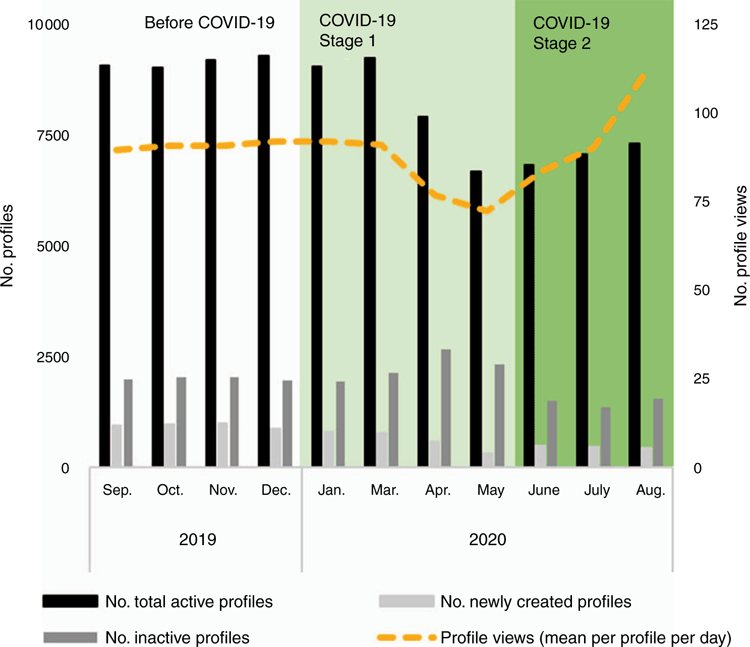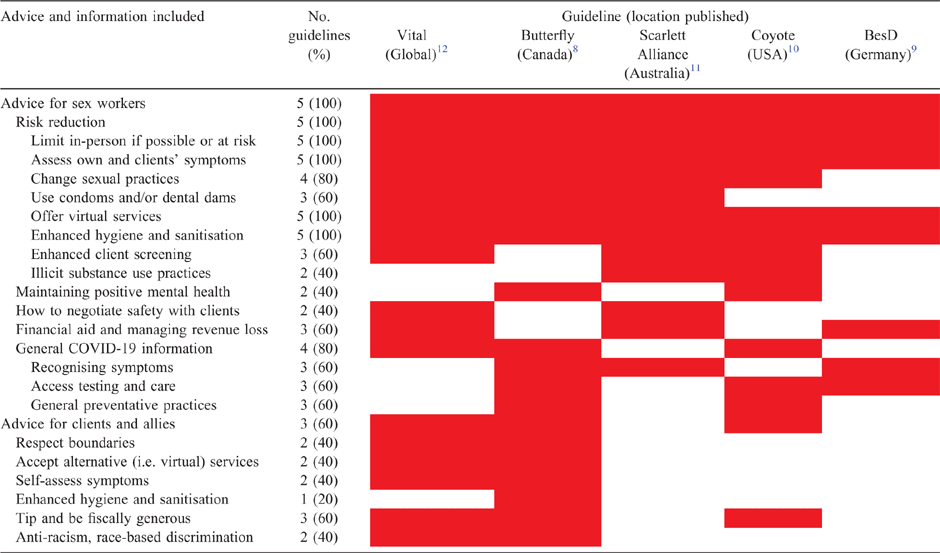Sex workers are returning to work and require enhanced support in the face of COVID-19: results from a longitudinal analysis of online sex work activity and a content analysis of safer sex work guidelines
Denton Callander A B H , Étienne Meunier A , Ryan DeVeau C , Christian Grov D , Basil Donovan B E , Victor Minichiello F G , Alicia Singham Goodwin A and Dustin T. Duncan A
A B H , Étienne Meunier A , Ryan DeVeau C , Christian Grov D , Basil Donovan B E , Victor Minichiello F G , Alicia Singham Goodwin A and Dustin T. Duncan A
A Mailman School of Public Health, Columbia University, 722 W 168th Street, New York, NY 10032, USA.
B The Kirby Institute for Infection and Immunity in Society, UNSW, Sydney, NSW 2052, Australia.
C Faculty of Arts, The University of Melbourne, 148 Royal Parade, Parkville, Vic. 3052, Australia.
D Graduate School of Public Health and Health Policy, City University of New York, 55 W 125th Street, New York, NY 10027, USA.
E Sydney Sexual Health Centre, 8 Macquarie Street, Sydney, NSW 2000, Australia.
F University of New England, Armidale, NSW 2351, Australia.
G School of Social Justice, Faculty of Law, Queensland University of Technology, 2 George Street, Brisbane City, Qld 4000, Australia.
H Corresponding author. Email: d.callander@columbia.edu
Sexual Health 17(4) 384-386 https://doi.org/10.1071/SH20128
Submitted: 21 July 2020 Accepted: 5 August 2020 Published: 25 August 2020
Journal Compilation © CSIRO 2020 Open Access CC BY
Abstract
Sex workers confront unique challenges in the face of COVID-19. Data from an international sex work website popular with cisgender men and transgender men and women suggest that, after a period of physical distancing, many sex workers are returning to in-person work: from May to August 2020, active sex work profiles increased 9.4% (P < 0.001) and newly created profiles increased by 35.6% (P < 0.001). Analysis of sex work and COVID-19 guidelines published by five community-based organisations found that they focused on altering sexual practices, enhancing hygiene and pivoting to virtual work. To capitalise on these guidelines, funding and research for implementation and evaluation are needed to support COVID-19 risk reduction strategies for sex workers.
Additional keywords: community health, community interventions, male sex work, risk reduction.
Earlier this year, Platt et al. advocated that ‘sex workers must not be forgotten in the COVID-19 response’.1 The physically intimate nature of sex work makes physical distancing difficult for those who rely on it as a source of income, and there is mounting evidence that sex workers face unique transmission risks, mental health needs and socioeconomic challenges relative to COVID-19 that have largely been ignored by health organisations and governments.2–4 However, sex workers have a long history of taking responsibility for public and their individual health within a model of risk reduction, especially relative to HIV,5 which in the COVID-19 context may provide an important avenue for intervention.
To better understand how COVID-19 is affecting sex workers, since the start of the pandemic our team has closely monitored the experiences of diverse sex work communities. As part of this effort, we have studied trends on an international sex work website popular with cisgender male and transgender male and female sex workers, finding that from January to May 2020 (the pandemic’s earliest months) online sex work activity decreased dramatically.6 However, results from a more recent analysis make it clear that such trends have started to reverse.
From May to August 2020, the number of active online profiles maintained by sex workers increased by 9.4% from 6661 to 7285 (inter-rate ratio (IRR) 1.03, 95% confidence interval (CI) 1.02–1.04, P < 0.001); deactivated profiles decreased by 33.0%, from 2311 to 1548 (IRR 0.71, 95% CI 0.70–0.73, P < 0.001); and newly created profiles increased by 35.6%, from 326 to 422 (IRR 1.10, 95% CI 1.06–1.15, P < 0.001). Visits to sex work profiles, an important marker of client interest, during this period increased by 55.1% (from a mean of 72.1 to 111.8 visits per profile per day; F = 273.1, β = 0.11, P < 0.001; Fig. 1).

|
The results of our updated analysis suggest that after a period of social distancing and self-isolation, cisgender male and transgender male and female sex workers, like other populations of sex workers and those in other industries, may be returning to in-person work. Although there is evidence that some sex workers have implemented COVID-19 risk reduction strategies of their own design (e.g. enhanced client screening protocols),6 the extent to which these are being taken up or how effectively they reduce risk remains unclear. Research to clarify what effective ‘safer sex’ looks like in the context of COVID-19 is sorely needed.
Promisingly, some community-based and peer-led sex worker organisations have produced COVID-19 safety guidelines. To better understand these, in July 2020 we conducted a content analysis7 using a convenience sample of five English-language guidelines identified through online keyword searches and consultation with sex work community members.8–12 Sampled guidelines focused on COVID-19 risk reduction strategies for sex workers, with common recommendations included limiting in-person work, assessing their own and their clients’ symptoms, enhancing hygiene practices (e.g. hand washing before and after handling money) and altering sexual practices (e.g. limit face-to-face sex acts; Table 1).

|
Guidelines occasionally provided resources around mental health and financial aid (e.g. accessing crowd-sourced schemes, applying for government support) and often advised sex workers to offer virtual services (although it has been reported that virtual sex work can have unique safety risks13). The guidelines we reviewed did not target any particular sex work subpopulation (e.g. men, women) and instead seemed to be written for a ‘general’ sex work audience, including three guidelines8,10,12 that provided advice for sex work clients and allies.
Guidelines such as these are important resources for sex workers but, to access their full potential, research and funding are needed to support dissemination (and evaluation) of community-led outreach and education. Further, drawing upon the long history of HIV and sexually transmissible infection (STI) prevention, distribution of COVID-19 protective equipment (e.g. gloves, face masks or shields) and culturally competent COVID-19 testing and care are vital missing pieces in the current sex work response. Researchers, community leaders and public health officials must come together to ensure that sex workers returning to and continuing in-person work are properly supported to manage individual and public health in this new COVID-19 era.
Conflicts of interest
The authors have no conflicts of interest to declare.
Acknowledgement
Data collection was supported, in part, by a grant from the Australian Research Council.
References
[1] Platt L, Elmes J, Stevenson L, Holt V, Rolles S, Stuart R. Sex workers must not be forgotten in the COVID-19 response. Lancet 2020; 396 9–11.| Sex workers must not be forgotten in the COVID-19 response.Crossref | GoogleScholarGoogle Scholar | 32422122PubMed |
[2] Howard S. COVID-19: health needs of sex workers are being sidelined, warn agencies. BMJ 2020; 369 m1867
| COVID-19: health needs of sex workers are being sidelined, warn agencies.Crossref | GoogleScholarGoogle Scholar | 32381484PubMed |
[3] Jozaghi E, Bird L. COVID-19 and sex workers: human rights, the struggle for safety and minimum income. Can J Public Health 2020; 111 406–7.
| COVID-19 and sex workers: human rights, the struggle for safety and minimum income.Crossref | GoogleScholarGoogle Scholar | 32488739PubMed |
[4] Karlis N. Sex workers are stressed, anxious and depressed amid COVID-19 pandemic. Salon, 22 March 2020. Available online at: https://www.salon.com/2020/03/22/sex-workers-are-stressed-anxious-and-depressed-amid-covid-19-pandemic/ [verified 7 July 2020].
[5] Rekart ML. Sex-work harm reduction. Lancet 2005; 366 2123–34.
| Sex-work harm reduction.Crossref | GoogleScholarGoogle Scholar | 16360791PubMed |
[6] Callander D, Meunier E, DeVeau R, Grov C, Donovan B, Minichiello V, et al Investigating the effects of COVID-19 on global male sex work populations: a longitudinal study of digital data. Sexually Transmitted Infections 2020;
| Investigating the effects of COVID-19 on global male sex work populations: a longitudinal study of digital data.Crossref | GoogleScholarGoogle Scholar | 32591488PubMed |
[7] Krippendorff K. Content analysis: an introduction to its methodology. Thousand Oaks, CA: SAGE Publications; 2020.
[8] Butterfly Asian and Migrant Sex Workers Support Network (BAMSW), Maggie’s Toronto Sex Workers Action Project (MSWAP). Sex work & COVID-19: guidelines for sex workers, clients, third parties, and allies. 2020. Available online at: https://doi.org/10.6084/m9.figshare.12789308.v1 [verified 11 August 2020].
[9] Berufsverband erotische und sexuelle Dienstleistungen e.V. (BesD). Corona-virus: what sex workers (and everyone else) should be aware of now. 2020. Available online at: https://doi.org/10.6084/m9.figshare.12789308.v1 [verified 11 August 2020].
[10] Krongelb M. COVID-19 sex worker harm reduction resources (U.S. Based). 2020. Available online at: https://doi.org/10.6084/m9.figshare.12789308.v1 [verified 11 August 2020].
[11] Scarlet Alliance, Australian Sex Worker Association. Red book – STI & BBV resources for sex workers by sex workers: COVID-19 (Coronavirus). 2020. Available online at: https://doi.org/10.6084/m9.figshare.12789308.v1 [verified 11 August 2020].
[12] Vital Strategies. Sex work, COVID-19 and harm reduction. 2020. Available online at: https://doi.org/10.6084/m9.figshare.12789308.v1 [verified 11 August 2020].
[13] Shehadi S, Partington M. Coronavirus: offline sex workers forced to start again online. BBC News, 7 April 2020. Available online at: https://www.bbc.com/news/technology-52183773 [verified 7 July 2020].


